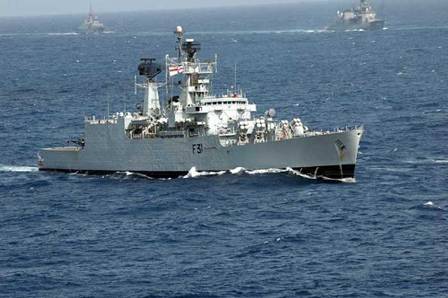Brahmaputra-class
Summary
| Origin country | 🇮🇳 India |
| Category | Destroyer |
| Subtype | ASM destroyer |
| Manufacturer | Garden Reach Shipbuilders and Engineers |
| Year commissioned | 2000 |
| Units |
F31 INS Brahmaputra F37 INS Beas F39 INS Betwa |
| Current operators | 🇮🇳 India |
Description
The Brahmaputra-class frigates, also known as Type 16A or Project 16A, are guided-missile frigates in service with the Indian Navy. They represent an evolution of the preceding Godavari class, being equipped with different armaments, configurations, and enhanced capabilities. Three ships of this class currently serve in the Indian Navy – INS Brahmaputra, INS Betwa, and INS Beas, each named after Indian rivers.
The decision to construct these frigates was part of an initiative by the Cabinet Committee on Political Affairs in 1986 to diversify India's warship production. These frigates were initially supposed to be additional Godavari-class vessels but were ultimately redesigned as Project 16A due to revisions in the Indian Navy's requirements. This led to frequent design changes, causing delays, and the new design was not finalized until September 1994. The construction of the INS Brahmaputra began in 1989 at Garden Reach Shipbuilders & Engineers (GRSE), Kolkata, and encountered further delays due to labor issues and equipment integration problems.
The Brahmaputra-class was originally intended to deploy the Trishul Surface-to-Air Missile (SAM) system, but due to delays, it was decided in 2001 to equip them with the Barak SAM instead. INS Betwa achieved a milestone by being the first Indian warship to successfully integrate indigenous combat data systems with various foreign and Indian weaponry and sensors.
Operational incidents include the tipping over of INS Betwa during a refit at Mumbai's naval dockyard on December 5, 2016, with the salvage and repair expected to take about two years.
These frigates are designed to house a complement of 350 personnel, including 40 officers and 13 aircrew. The ships boast sophisticated radar and sonar systems, including Bharat RAWS-03 S-band radar and Bharat/Signaal RAWL-02 D-band radar for air/surface searches, as well as sonar arrays for submarine detection.
Their armament includes sixteen 3M-24E (Kh-35 Uran) anti-ship missiles, an OTO Melera 76 mm main gun, four AK-630 Gatling guns, six 324 mm torpedo tubes carrying Whitehead A244S anti-submarine torpedoes, and the Barak SAM system for aerial threats.
The Brahmaputra-class can carry aircraft to extend their operational capabilities, typically embarking either two Sea King Mk.42B or a combination of the HAL Chetak and a Sea King Mk.42B, each equipped for both anti-ship and anti-submarine roles.
The Brahmaputra-class serves exclusively in the Indian Navy, with INS Brahmaputra commissioned on 14 April 2000, followed by the commissioning of INS Betwa and INS Beas. Despite challenges faced during their construction and operational history, the indigenization of combat systems aboard these frigates represents a significant step in India’s quest for self-reliance in maritime defense technology.
Technical specifications
| Displacement | 4450 tons |
| Range | 8000 km at 12 knots |
| Crew | 300 members |
| Width | 14.5 m (47.6 ft) |
| Length | 126.4 m (414.7 ft) |
| Propulsion | 2 turbo-electric motors with a power of 30,000 hp - 2 propellers |
| Thrust | 1500 hp |
| Armament | 16 SS-N-25 (IV 4) + 1 Trishul (20 missiles) + 1 OTO-Melara Compact 76 mm + 4 AK-630 30 mm + 6 TLT Ilas 3 + 2 Sea King. |
| Maximum speed | 30 knots |
